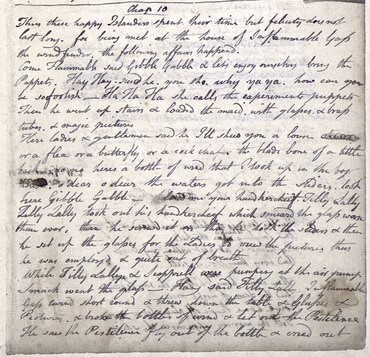In my last post, we were left wondering what the “P&S.” or “E&S.” written at the bottom of one of the “Pale desire” manuscript pages could mean. (If you haven’t been keeping up, you can find the first and second installments of our saga here and here.) Well, Sandy and I both took a stab at it.
“Pale desire” is full of abstract concepts personified as gods. These generally breed, dwell together, act in concert, etc.– and so there are multiple references to “Conceit & Emulation,” “Scorn & Slander,” and so on. I wondered if “P&S.”/”E&S.” could be an abbreviated reference to the names of two of these gods and perhaps be part of an abandoned addition. (The abbreviation is not deleted, but Blake sometimes abandons additions without bothering to strike them elsewhere in this manuscript.) To run with my theory– on the page in which the abbreviation appears, there are mentions of Slander, Shame, Strife, Scorn, Self love, and Suspicion (to cover “S”); Pride and Policy (to cover “P”); and Emulation (to cover “E”). I thought it likely that the abbreviation would be “P&S.”, since Emulation is only mentioned in tandem with Policy and Conceit, while “P” and “S” names are connected throughout the object. For example, “Scorn waits on Pride,” Policy and Slander “drudge” for Hate, and Policy is the son of Shame.
However, I had two problems with this scenario. The first was that, though Blake uses ampersands to link gods, they are all alpha-shaped. Since a formal ampersand is used in the abbreviation, it seemed more likely that this abbreviation was something set apart from Blake’s comparatively spontaneous composition. Perhaps it was an abbreviation that he had used in the past in this particular form, a whole unit (as it were) in his mind. My second concern was that Blake does not abbreviate the names of the gods elsewhere, and therefore, it is less likely that he would do so here.
Sandy was also inclined to read the abbreviation as “P&S.”– but for an entirely different reason. He suggested it could be an abbreviation for “pinxit et sculpsit,” which are Latin terms sometimes added to the signature of an artist to indicate that he or she painted and (in Blake’s case) engraved a particular piece. However, Sandy did not know why such an abbreviation would appear at the bottom of a page filled with text.
Since we were uncertain, I contacted Robert Essick (one of the Blake Archive editors). This is fairly standard practice for me. When I don’t know what’s going on, if I’m not writing to Morris Eaves, I’m writing to Bob. Anyway, in considering the possibility that the “Pale desire” inscription could be an abbreviation related to illustration, Bob noted that Blake sometimes added an abbreviation for “delineavit et sculpsit” to his signature. Bob gave the example of Blake’s signature on what may be his first original book illustration (a plate in The Royal Universal Family Bible), which is followed by “d & sc”. Sandy provided this image of that abbreviation:
Bob added that Blake would have been working on the plate for this particular illustration in 1781 and continued:
“The MS [of “Pale desire”] is usually dated to the late 1770s or early 80s; the pencil revisions in the MS could date from about the time Blake was working on this plate. So some connection there with the ‘P&S.’ inscription? That is, Blake was preparing for the first time to sign an engraving in a way that indicated that he both composed and executed the design. So, while working on the MS, he did a practice run in pencil of this sort of inscription to follow his name…. He changed to the more usual ‘d & sc’ on the copper, but the MS is a trial run with the with the ‘P’ rather than a ‘D’ (or ‘d’) and ‘S’ rather than ‘Sc’ (or ‘sc’).”
Unfortunately, while it is possible that this inscription is indeed an abbreviation for “pinxit et sculpsit,” the rest of the writing on the “Pale desire” manuscript pertains to the work beginning “then She bore Pale desire” and that beginning “Woe cried the muse,” which immediately follows. Since none of these pages contain random jottings or notes (as is the case with some of Blake’s other manuscript material), it may be less likely that an inscription unrelated to these specific pieces would appear here.
In short, we still aren’t entirely sure what this inscription stands for– and it’s possible that it may be something we have not even considered. Although, Bob did add that, if you want to buy his particular theory, he also has this bridge….
—




